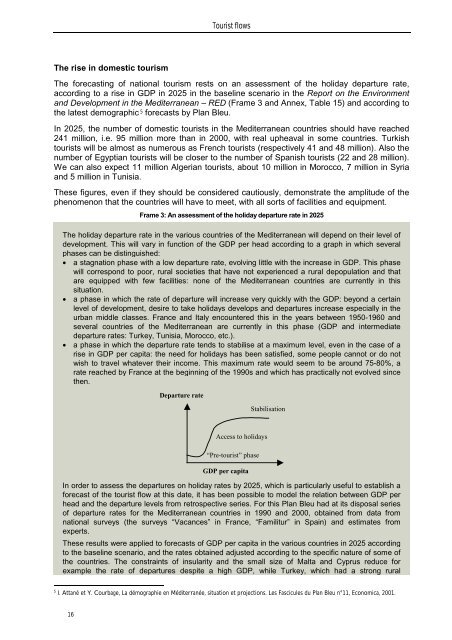dossier sur le tourisme et le développement durable
dossier sur le tourisme et le développement durable
dossier sur le tourisme et le développement durable
Create successful ePaper yourself
Turn your PDF publications into a flip-book with our unique Google optimized e-Paper software.
The rise in domestic tourism<br />
16<br />
Tourist flows<br />
The forecasting of national tourism rests on an assessment of the holiday departure rate,<br />
according to a rise in GDP in 2025 in the baseline scenario in the Report on the Environment<br />
and Development in the Mediterranean – RED (Frame 3 and Annex, Tab<strong>le</strong> 15) and according to<br />
the latest demographic 5 forecasts by Plan B<strong>le</strong>u.<br />
In 2025, the number of domestic tourists in the Mediterranean countries should have reached<br />
241 million, i.e. 95 million more than in 2000, with real upheaval in some countries. Turkish<br />
tourists will be almost as numerous as French tourists (respectively 41 and 48 million). Also the<br />
number of Egyptian tourists will be closer to the number of Spanish tourists (22 and 28 million).<br />
We can also expect 11 million Algerian tourists, about 10 million in Morocco, 7 million in Syria<br />
and 5 million in Tunisia.<br />
These figures, even if they should be considered cautiously, demonstrate the amplitude of the<br />
phenomenon that the countries will have to me<strong>et</strong>, with all sorts of facilities and equipment.<br />
Frame 3: An assessment of the holiday departure rate in 2025<br />
The holiday departure rate in the various countries of the Mediterranean will depend on their <strong>le</strong>vel of<br />
development. This will vary in function of the GDP per head according to a graph in which several<br />
phases can be distinguished:<br />
• a stagnation phase with a low departure rate, evolving litt<strong>le</strong> with the increase in GDP. This phase<br />
will correspond to poor, rural soci<strong>et</strong>ies that have not experienced a rural depopulation and that<br />
are equipped with few facilities: none of the Mediterranean countries are currently in this<br />
situation.<br />
• a phase in which the rate of departure will increase very quickly with the GDP: beyond a certain<br />
<strong>le</strong>vel of development, desire to take holidays develops and departures increase especially in the<br />
urban midd<strong>le</strong> classes. France and Italy encountered this in the years b<strong>et</strong>ween 1950-1960 and<br />
several countries of the Mediterranean are currently in this phase (GDP and intermediate<br />
departure rates: Turkey, Tunisia, Morocco, <strong>et</strong>c.).<br />
• a phase in which the departure rate tends to stabilise at a maximum <strong>le</strong>vel, even in the case of a<br />
rise in GDP per capita: the need for holidays has been satisfied, some peop<strong>le</strong> cannot or do not<br />
wish to travel whatever their income. This maximum rate would seem to be around 75-80%, a<br />
rate reached by France at the beginning of the 1990s and which has practically not evolved since<br />
then.<br />
Departure rate<br />
Access to holidays<br />
“Pre-tourist” phase<br />
GDP per capita<br />
Stabilisation<br />
In order to assess the departures on holiday rates by 2025, which is particularly useful to establish a<br />
forecast of the tourist flow at this date, it has been possib<strong>le</strong> to model the relation b<strong>et</strong>ween GDP per<br />
head and the departure <strong>le</strong>vels from r<strong>et</strong>rospective series. For this Plan B<strong>le</strong>u had at its disposal series<br />
of departure rates for the Mediterranean countries in 1990 and 2000, obtained from data from<br />
national <strong>sur</strong>veys (the <strong>sur</strong>veys “Vacances” in France, “Familitur” in Spain) and estimates from<br />
experts.<br />
These results were applied to forecasts of GDP per capita in the various countries in 2025 according<br />
to the baseline scenario, and the rates obtained adjusted according to the specific nature of some of<br />
the countries. The constraints of insularity and the small size of Malta and Cyprus reduce for<br />
examp<strong>le</strong> the rate of departures despite a high GDP, whi<strong>le</strong> Turkey, which had a strong rural<br />
5 I. Attané <strong>et</strong> Y. Courbage, La démographie en Méditerranée, situation <strong>et</strong> projections. Les Fascicu<strong>le</strong>s du Plan B<strong>le</strong>u n°11, Economica, 2001.
















